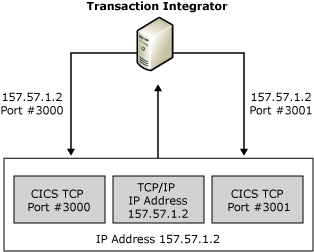TI TCP/IP Load Balancing
Transaction Integrator (TI) can load balance TCP/IP ports when you have configured TI for CICS and IMS TCP/IP remote environments. To enable load balancing, supply multiple TCP port numbers when you create the remote environment; this enables connections to redundant CICS or IMS regions on a single host system. The following figure shows the TI TCP port load balancing solution.

Transaction Integrator receiving a TCP/IP address and sending it to CICS ports 3000 and 3001
The first TCP port is used by the first transaction and will take turns going through all the configured ports for each transaction that is invoked.
Additional host configuration details for CICS and IMS are included in the following sections.
CICS TCP/IP Platform Requirements
The version dependencies for CICS include the following:
TCP/IP version 3R2
CICS version 3.3 or later
Connections to CICS Using TCP/IP
CICS uses the IBM-supplied Concurrent Listener (program EZACIC02, transaction ID CSKL) to establish an interaction with TCP/IP. The Listener runs as a CICS task to help facilitate the connection process. The Listener transaction starts automatically when CICS TCP/IP is started and enabled. When the Listener starts, it obtains a socket on which it can listen for connection requests from TCP/IP. The Listener binds this socket to a specified port, and then it waits for a client request on that port. TCP/IP maintains a relationship of a port number to a CICS job. When a client makes a request on a port associated with CICS, TCP/IP forwards the connection request to the Listener in that CICS job.
TCP/IP-to-CICS Configuration
A TCP/IP port number is associated with a CICS region in the TCP/IP profile data set (hlq.PROFILE.TCPIP). The port statement is used to define this relationship. An example of a port statement that associates port 3000 with CICS job CICSRG follows:
3000 TCP CICSRG
CICS to TCP/IP Configuration
The following sample host definition shows configuration parameters for CICS-to-TCP using the EZAC transaction. The items in bold type are CICS transactions.
ENTER ONE OF THE FOLLOWING
CICS ===> yes Enter Yes|No
LISTENER ===> Enter Yes|No
ENTER ALL FIELDS
APPLID ===> CICSRG APPLID of CICS System
EZAC,DEFINE,CICS
OVERTYPE TO ENTER
APPLID ===> CICSRG APPLID of CICS System
TCPADDR ===> TCPIP Name of TCP Address Space
NTASKS ===> 020 Number of Reusable Tasks
DPRTY ===> 000 DPRTY value for ATTACH
CACHMIN ===> 015 Minimum Refresh Time for Cache
CACHMAX ===> 030 Maximum Refresh Time for Cache
CACHRES ===> 010 Maximum number of Resolvers
ERRORTD ===> CSMT TD Queue for Error Messages
The following sample host definition shows configuration parameters for the CICS Concurrent Listener using the EZAC transaction. The items in bold type are CICS transactions.
EZAC,DEFINE
ENTER ONE OF THE FOLLOWING
CICS ===> Enter Yes|No
LISTENER ===> yes Enter Yes|No
ENTER ALL FIELDS
APPLID ===> CICSRG APPLID of CICS System
NAME ===> xyz TRANSACTION NAME OF LISTENER
EZAC,DEFINE,LISTENER
OVERTYPE TO ENTER
APPLID ===> CICSRG APPLID of CICS System
TRANID ===> XYZ Transaction Name of Listener
PORT ===> 03000 Port Number of Listener
IMMEDIATE ===> YES Immediate Startup Yes|No
BACKLOG ===> 010 Backlog Value for Listener
NUMSOCK ===> 050 Number of Sockets in Listener
MINMSGL ===> 004 Minimum Message Length
ACCTIME ===> 060 Timeout Value for ACCEPT
GIVTIME ===> 030 Timeout Value for GIVESOCKET
REATIME ===> 000 Timeout Value for READ
FASTRD ===> YES Read Immediately Yes|No
TRANTRN ===> YES Translate TRNID Yes|No
TRANUSR ===> YES Translate User Data Yes|No
SECEXIT ===> Name of Security Exit
IMS TCP/IP Platform Requirements
The version dependencies for IMS include the following:
TCP/IP version 3R2
IMS version 4 or later
Connections to IMS using TCP/IP
IMS uses a Listener to establish an interaction with TCP/IP. A Listener in an IMS Batch Message Processing (BMP) helps facilitate the connection process. When the Listener starts, it obtains a socket on which it can listen for connection requests from TCP/IP. The Listener binds this socket to a specified port, and then waits for a client request on that port.
TCP/IP maintains a relationship of a port number to an IMS Listener BMP. When a client makes a request on a port associated with IMS, TCP/IP forwards the connection request to the Listener in that BMP.
TCP/IP to IMS Configuration
A TCP/IP port number is associated with an IMS Batch Processing Region (BPR) in the TCP/IP profile data set (hlq.PROFILE.TCPIP). The port statement is used to define this relationship. An example of a port statement that associates port 3000 with IMS batch region with a job name of WNWIBPR1 is:
3000 TCP WNWIBPR1
IMS to TCP/IP Configuration
An IMS MPP is started specifying the program name IMS IBM supplied Listener program (EZAIMSLN). This Listener reads a configuration file identified by the DD statement LSTNCFG. This configuration data set contains one or more the following startup parameter sets (one set for each transaction defined for least one CR):
TCPIP statement
LISTENER statement
TRANSACTION statement
The TCPIP statement is used to identify the job name for the TCP/IP address space that will manage connection for this listener.
The LISTENER statement is used to specify the port number that this Listener will be using. This statement also specifies other port-related parameters such as backlog, time out values, and so on.
The TRANSACTION statement defines a list of transaction that this Listener can start. In addition, this statement defines whether the implicit or explicit connection mode is used.
The Listener uses these three parameter statements to inform the Listener which TCP/IP port to use and which transactions can be accessed through TCP/IP.
Here is a sample of an IMS-to-TCP/IP host definition:
TCPIP ADDRSPC=WNWTCP31
LISTENER PORT=4000 BACKLOG=50
TRANSACTION NAME=TRANIMPL TYPE=IMPLICIT
TRANSACTION NAME=TRANEXPL TYPE=EXPLICIT